Do you cook with fresh herbs or do you tend to stick with the dried varieties? Not only are fresh herbs a flavor and freshness powerhouse, but they also bring nutritional benefits and beautiful color to dishes. So, I wanted to create a guide on how to use fresh herbs. In this overview I share information on the nutritional benefits of fresh herbs, tips on how to plant a simple herb garden, info on how to cook with fresh herbs, ideas on how to use up extra fresh herbs, and tricks for storing, freezing, and drying them for maximum usage.
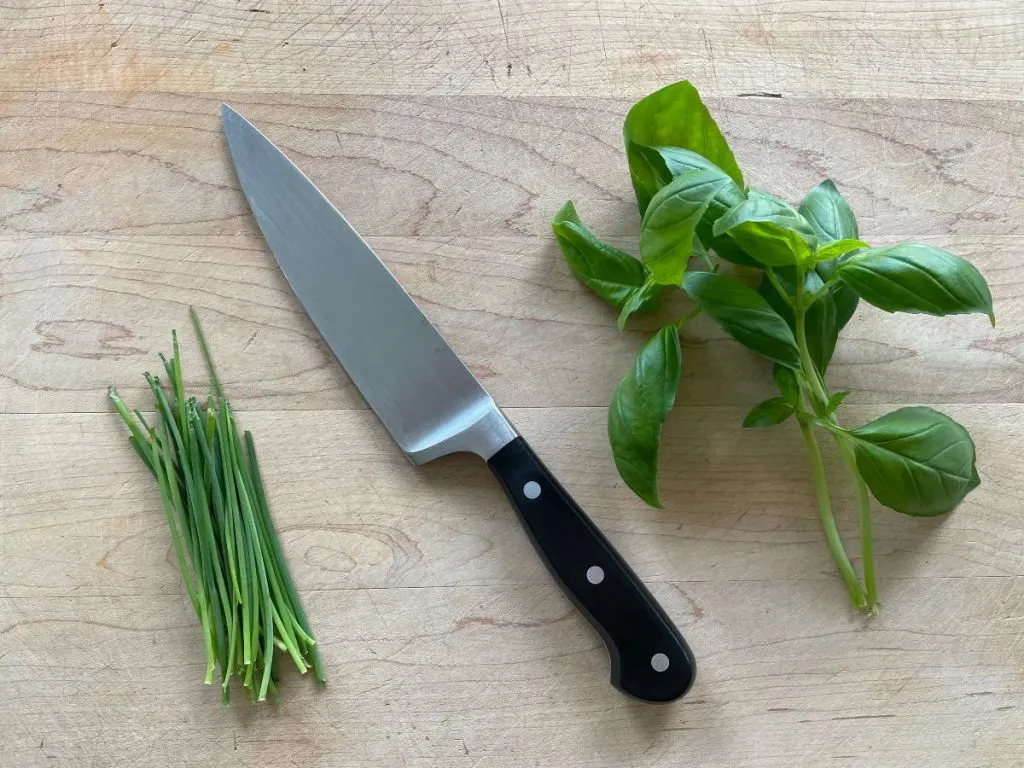
Nutritional Benefits of Fresh Herbs
While the fact that fresh herbs bring brightness and flavor to dishes is in and of itself enough of a reason to enjoy them, they also offer a number of powerful health benefits that are worth noting.
It makes perfect sense that herbs would be health heavyweights. They are green (and we know that greens top all the nutritional lists), have intense flavor, and have been used by humans for thousands of years not only for cooking but for healing, too. (Dried spices are also rife with health benefits, but we’ll save that for another post…)
Here are just a few of the benefits of common herbs:
Basil
Compounds in basil promote heart health and have anti-inflammatory and anti-bacterial properties. May also prevent acne and speed healing.
Cilantro
Its powerful nutrients may help improve symptoms of arthritis, improve cholesterol levels, ease nausea, and detoxify the body.
Mint
A natural breath freshener, digestive remedy, diuretic, pain reliever, and decongestant. May also inhibit growth of cancerous cells.
Parsley
Protects the heart and may inhibit tumor formation. Can also be used to cleanse the system and treat digestive disorders.
Oregano
Rich in vitamin K, iron, and omega-3s, oregano helps protect the heart and prevent diseases like cancer. May also relieve sore muscles, and treat allergies and intestinal problems.
Rosemary
Its potent antioxidants may prevent cancer and Alzheimer’s disease and calm jangled nerves.
Sage
Promotes better brain function and has antioxidant and anti-inflammatory properties.
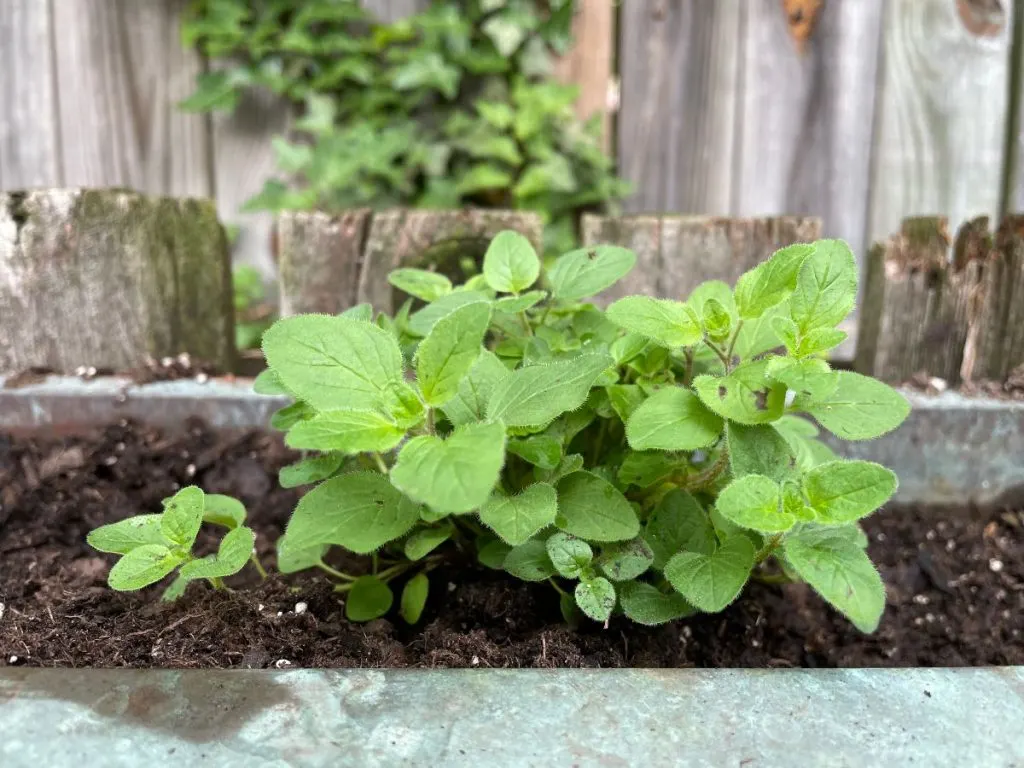
How to Plant a Simple Herb Garden
While I love the aromatic flavor and nutritional benefits that fresh herbs add to almost any dish, I don’t like the expense and waste of those plastic herb packets they sell at the grocery store, so every spring I plant a simple herb garden in our back yard.
It only takes about 10 minutes to transfer a few basic herbs from their temporary containers from the farmer’s market or garden store, which sell in our area for about $3 each, to pots on your deck or balcony, or into the soil in your backyard. And, once you’ve set up your little herb garden, you’ll have fresh herbs to cook with for months, as long as you keep them watered and pruned!
Some herbs, like oregano, mint, rosemary, and chives, will likely come back year after year so you won’t have to buy them again, while others such as basil, parsley, sage, and dill will likely need annual replacement.
Each spring I plant my favorite herbs in the garden. Some of them like basil, parsley, oregano, rosemary, and mint, I clip and use constantly. While others, like sage, thyme, and dill, languish for most of the season, despite my best intentions.
I love the convenience of having the herbs right outside my door. I also adore the bright and fresh flavors they add to my recipes, and I think they’re pretty to look at through my window.
Here’s how to plant a simple herb garden on your deck or in your garden:
Choose the right time to plant
Wait until there is no more chance of an overnight frost in your area before you invest in fresh herb plants (you can find the general rule of thumb for your area here). Most herbs, especially annuals, don’t do well in very cold temperatures.
Pick a sunny spot for your herb garden
Choose a spot that gets at least 6 hours of direct sunlight a day. If you’ve got a deck, it might be the ideal place since it’s easy to step out there while preparing dinner and snip the evening’s herbs.
Note: Getting the herbs can be a fun job for kids! Encourage them to smell the collection and help them learn to identify which fresh herbs are which by smell, taste, and appearance.
Select your herbs
I plant at least 3 pots of basil and one pot each of chives, cilantro, rosemary, parsley, thyme, mint, sage, and oregano.
Note: Make sure to get potting soil and medium to large pots, if you don’t have them already.
Transfer to new pots
When you buy potted herbs, you will want to transplant them to bigger pots, as these pots were designed just for getting the plants started and will eventually be too small for the herbs.
To transplant them, gently remove them from their current pots and take a look at the roots. If the plants have been in their pots for a while, then the roots will have grown around the circumference of the pot. Gently break up these root balls with your fingers to allow the roots to expand in the new pot.
Place some potting soil in the bottom of the new pot, put your herb plant in, add additional potting soil, and water generously.
Keep the herbs watered
The hardest part of maintaining an herb garden is keeping the plants watered throughout the hot summer so the roots don’t dry out. If it doesn’t rain much, you’ll need to water them thoroughly once or twice a week. If you live in a hot climate, however, you’ll need to water your herbs nearly every day—which is an ideal chore for kids of all ages to help with.
Prune the herbs for maximum growth
Once the herb plants have filled out a bit, prune them to keep them growing outward, not just upward. For basil, once the plant has 3 sets of leaves, cut the top off just above the 3rd set, and continue to do this during the growing season for all the offshoots. Also, remove the flowers as they bloom. (You can add the trimmings to a compost pile or add the trimmed leaves to your water glass for a lovely flavored water experience!)
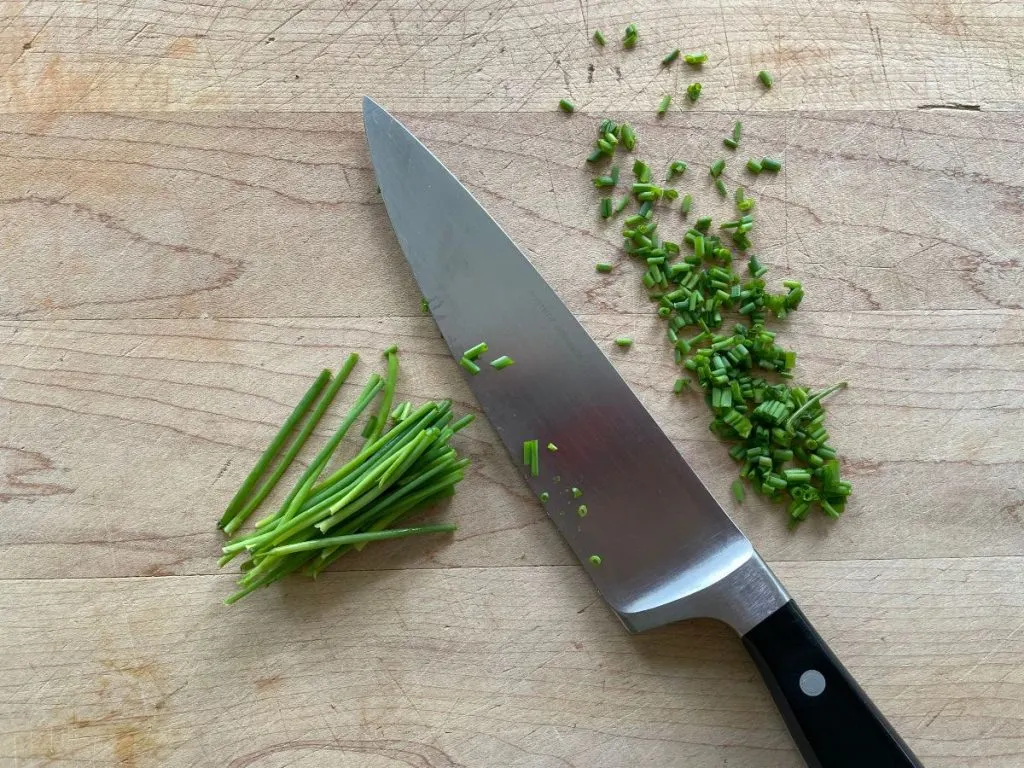
How to Cook with Fresh Herbs
While cooking with dried herbs is pretty straightforward, people can sometimes feel daunted by cooking with the fresh varieties. Here are some tips on how to cook with fresh herbs to take away that reluctance so that you can start enjoying these bright, fresh flavor bombs!
A Note on Quantity: Dried herbs have a more concentrated flavor than fresh ones and, therefore, cooking with them requires different amounts. The general rule of thumb is that you need three times as much fresh as you would need dried, although, as with all seasoning, I recommend starting slow, taste-testing, and adding more as needed.
Just like vegetables, different herbs should be prepared and cooked differently. So below you’ll find tips on how to cook with fresh herbs organized by each individual herb.
Basil
There are many varieties of this bright, fresh herb. But for this roundup, we’ll focus on the two most common: Genovese and Thai Basil. Genovese Basil is most commonly associated with Mediterranean cuisine and brings a brightness to dishes. It is often used in tomato sauces, pesto sauce, meat dishes, and salads. Thai Basil, on the other hand, has a slightly spicier quality to it and is commonly found in Asian and Indian cooking, including curries, grilled meat dishes, and stir fries. To prepare either kind of basil for cooking, remove the stems as the leaves contain the most flavor and add to your dish at the very end of cooking to get the most flavor and prevent browning.
Chives
This garlicky-tasting cousin of the onion is a wonderful addition to many dishes from eggs to potato salad. You can eat and enjoy the entire stalk and even the purple flowers that sometimes accompany it. Like basil, it is best added at the very end of cooking.
Cilantro
A staple in Asian and Latin American cooking, this herb brings a real zing to dishes. While most people focus on the leaves, both the leaves and stems offer great flavor. It can be eaten both raw or cooked. When adding it to a cooked dish, add towards the end of cooking to maintain the most flavor.
Note: While most people love cilantro, there are those who strongly dislike it. This is because, for them, the herb tastes like soap, which can quickly overpower the flavor of a meal. If this is an issue for anyone you will be serving the dish to, just serve the cilantro on the side.
Dill
This tangy, bright herb is prevalent in German and Scandinavian cuisine. While it may look delicate as a plant, its flavor is quite strong and earthy. It’s wonderful with poultry, fish, vegetables, and creamy dishes. It also pairs nicely with lemon. You can use both the stems and fronds of the plant and adding it at the end of cooking will give you the strongest flavor.
Marjoram
With its delicate, citrusy, floral flavor, marjoram is a wonderful herb to use with meats, in stews, in tomato-based dishes, and in salad dressings to brighten flavor. It is also a nice herb to use with vegetables. While dried marjoram should be added early in the cooking process to allow the flavor to be released, fresh marjoram should be added at the very last minute.
Mint
This crispy, bright herb enlivens both savory and sweet dishes. It is widely used in Middle Eastern and Greek cuisine. Mint packs a serious punch when it comes to flavor, so it is best to use it sparingly and then add more after tasting the dish.
Oregano
This potent herb is used in cuisines throughout the world, but there are two kinds that have different profiles that should be noted. Mexican oregano tends to have a more citrusy flavor and pairs well with spices such as cumin and chili peppers. Mediterranean oregano, on the other hand, is more closely related to thyme and basil and has a more woodsy flavor. The timing of when to add your oregano depends on what you want it to do for the dish. If you want a subtle undertone, then add it at the beginning of cooking, but if you want to highlight its peppery, citrusy qualities, then adding it at the end is advisable.
Parsley
There are two common types of parsley, flat-leaf (Italian) or curly. The flat-leaf variety offers more flavor and a smoother texture and mouthfeel, but both versions offer a wonderful, bright flavor to dishes. While we tend to focus on the leaves, parsley stems are just as flavorful and can be chopped and added to a recipe or saved in a freezer bag to add to your next batch of homemade stock. This popular herb can be enjoyed both raw and cooked and can be added at really anytime in the cooking process, thanks to its strong, bright flavor.
Rosemary
A wonderful, year-round herb, rosemary offers a lovely, woody flavor to soups, stews, sauces, baked goods, and roasted vegetables. It also makes a wonderful addition to lighter fare such as smoothies and even lemonade. To prepare your fresh rosemary, you want to remove it from its woody stem and then chop or mince the needle-like leaves. Because it is so robust, rosemary can be added at really any stage in cooking without losing flavor like some other fresh herbs and, in fact, it will be better if added earlier in the cooking process.
Sage
This herb is popular in both American and European cuisine. Sage is especially known to work well with meats and creamy dishes. It’s a very pungent herb and should be used sparingly so as not to overpower your dish and does best when it is paired with other herbs and spices such as garlic, rosemary, and bay leaf. To prepare it, remove the leaves from the stem and either chop or chiffonade the leaves. While fresh sage is pungent enough to be added early on in the cooking process, it will do better if added towards the end (say the last 5-10 minutes of cooking), but do make sure to allow some cooking time as the raw leaves have an unpleasant cottony texture to them.
Tarragon
Popular in French cuisine, tarragon has a slightly bittersweet flavor profile similar to that of anise (licorice). It works very well with meats, but also in creamy sauces. While dried tarragon does best in long-slow cooking, fresh tarragon should be added at the last minute to give the most flavor.
Thyme
A common ingredient in French cuisine, thyme offers a woody yet floral flavor and is wonderful on chicken, in baked goods, in soups and stews, and on vegetables. Like rosemary, you want to remove the small leaves from their woody stems, but they require no chopping or mincing because they are already such small leaves. Thyme can be added to cooking at any time in the process and is also delicious raw.
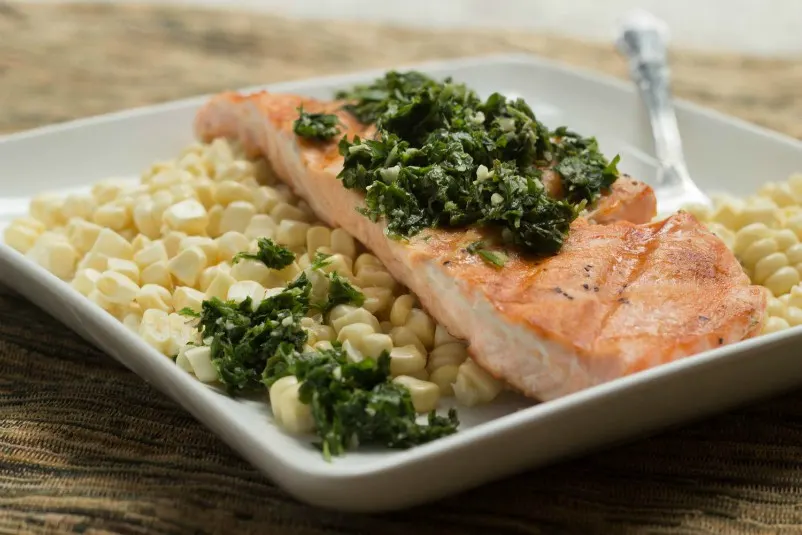
How to Use Extra Herbs
While fresh herbs can almost always be substituted for dried in recipes and are delicious as an additional garnish on recipes, oftentimes you will find that you have more fresh herbs than you can use in one dish. Here are some great ways to use up your leftover fresh herbs.
- Mix a handful of fresh oregano, mint, dill, or basil leaves into green salads, potato salad, or tuna salad.
- Make pesto out of basil, parsley, or mint, and use it as a topping for pasta, pizza, fish, chicken, sandwiches, or crackers. Pesto also freezes well, so you can enjoy some now and some later.
- Top pizza with fresh basil or oregano.
- Add fresh basil or oregano to sandwiches and wraps.
- Add herbs to almost any pasta dish, especially pasta salads. This Pasta Salad with Roasted Summer Vegetables and Fresh Mozzarella is a great choice.
- Sprinkle chopped fresh herbs in or on top of omelets or frittatas.
- Before or after roasting vegetables or potatoes, toss them with rosemary, thyme, dill, or oregano.
- Rub meat or fish with fresh herbs before baking or grilling it. This Grilled Salmon has you top the dish with a fresh herb pesto right after grilling.
- Add sprigs of fresh mint, rosemary, or sage to lemonade or iced tea.
- Use herbs as a garnish on a platter, or put bunches in small vases for table decorations.
- Bring a bunch to a friend or neighbor as a sweet summertime surprise.
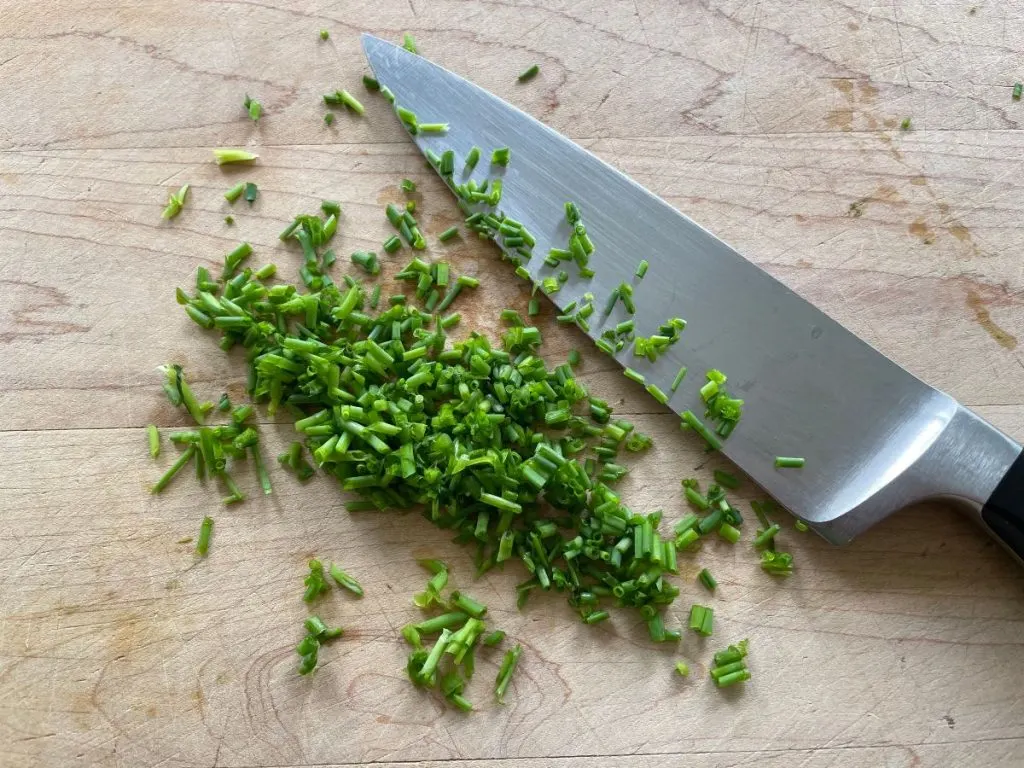
How to Store Fresh Herbs
How often have you bought a bunch of parsley or a packet of rosemary to use some for a recipe and then struggle to keep it from getting gross before you can use it all up? Well, no longer!
Below I outline how to store fresh herbs in the refrigerator, how to freeze fresh herbs, and how to dry them. With these quick and easy steps, you can store your fresh herbs so that they last longer, allowing you more time to enjoy the flavor they bring to dishes.
How to Store Fresh Herbs in the Refrigerator
It turns out that there are two types of herbs when it comes to storage: tender and hard. Tender herbs are those that have a softer stem such as parsley, cilantro, basil, mint, dill, and tarragon. Hard herbs are the ones with a woody stem such as rosemary, oregano, thyme, and marjoram.
When you store the herbs following these directions you will be able to extend the life of your herbs for 3 weeks (parsley, cilantro, dill, tarragon, and rosemary), 2 weeks (basil, mint, oregano, thyme, sage), or 1 week (chives).
How to Store Tender Fresh Herbs in the Refrigerator
With one exception (basil, which I’ll get to in a second), all of the tender herbs such as parsley, cilantro, mint, dill, and tarragon can be stored in the same manner:
- Trim the bottoms of the stems like you would a bouquet of flowers and remove any darkened leaves
- Place the bunch of herbs into a small glass or mason jar that has about 1-inch of water in it
- Cover the herbs loosely with a plastic bag and store in the refrigerator, changing the water if it discolors
How to Store Fresh Basil
Basil is a bit more delicate than the other herbs. Here is how to store it for maximum freshness:
- Trim the bottoms of the stems like you would a bouquet of flowers and remove any darkened leaves
- Place the bunch of herbs into a small glass or mason jar that has about 1-inch of water in it
- Store the basil not in the refrigerator, but on your kitchen counter, like a vase of flowers (added perk: having it out will remind you to use it up!)
How to Store Hard Fresh Herbs in the Refrigerator
For the fresh herbs that have a woody stem such as rosemary, thyme, oregano, marjoram, and sage (and also chives!), the best way to store them is a little different:
- Lay the herbs lengthwise on a piece of slightly damp paper towel
- Loosely roll the paper towel with the herbs inside and place into a resealable plastic bag or wrap in plastic wrap and then store in the refrigerator
How to Freeze Herbs
Although the herbs will become limp and darken in the process, which takes away the opportunity to use them as an accent or garnish, freezing fresh herbs maintains their flavor making them useful in cooked dishes. Personally, I love to use frozen herbs in sauces, soups, stews, sautés, and stir fries.
Frozen herbs will keep their flavor for several months and, unlike dried herbs, where the flavor gets more concentrated when drying, frozen herbs can be used in the same proportion as fresh herbs.
There are two different ways to freeze your fresh herbs, on their own or in oil. Below are directions for both.
How To Freeze Herbs on Their Own
- Harvest the freshest, healthiest leaves
- Wash and pat dry with paper towels
- Spread the individual leaves on a small tray or cookie sheet. Freezing the leaves flat and individually will prevent them from freezing together into a brick
- Cover and place the tray of leaves into the freezer
- When frozen solid (this should take about an hour), place in airtight containers or bags and return to the freezer
Note: Frozen individually, the herb’s leaves will not meld together.
How To Freeze Herbs in Oil
- Harvest the freshest, healthiest leaves
- Wash and pat dry with paper towels
- Chop the herbs
- Fill ice cube trays about 2/3 full with the chopped herbs
- Fill the ice cube trays the rest of the way with extra virgin olive oil and place in the freezer
- Once the cubes have frozen completely, pop the cubes out and store in a freezer bag or sealed container
- When you want to cook with them, simple place a cube or two into your skillet or pot, turn on the heat, and allow the oil to melt then proceed with your recipe
How to Dry Fresh Herbs
While fresh herbs that have a high moisture content, such as basil, mint, and chives, require a dehydrator to effectively dry them, a number of fresh herbs can easily be dried for long-term storage.
Fresh herbs that tend to dry out easily include: dill, marjoram, oregano, rosemary, and thyme. Here are the simple steps you can take to successful dry your own herbs:
- Cut off any excess stems/branches, leaving 1-inch of stem at the bottom
- Remove any dry or discolored leaves
- Gently shake the herbs to remove any excess dirt or bugs
- Bunch about 6 stems together and tie them together, using that 1-inch of stem you left exposed
- Hang the bundle upside down in a warm, airy room for about 2 weeks (fun extra tip: if you want to make sure you catch any leaves that fall off during the drying process, cut holes into the sides of a paper bag, place the bundle upside down in the bag, and then hang the bag rather than the bundle of herbs)
- Once the herbs have dried, you can use your fingers to gently remove the leaves from the stems or just place the stems into an airtight container and store for up to one year
A note on drying herbs in the microwave: While this is an option, I do not recommend going this route as it also slightly cooks the herbs, reducing their flavor.
Do you have any other tips for growing, using, or extending the life of fresh herbs? Please share them in the comments!
Looking for more cooking inspiration, check out The Scramble’s family-friendly meal plans to see just how simple getting dinner on the table can be!

DIY Kitchen Window Herb Garden - Nurture, Nature, and Nutmeg
Wednesday 6th of July 2022
[…] have planted your herbs and watched them grow! It is so exciting, but now what? There are so many different uses for herbs around the house. Common uses for herbs include making teas, homemade remedies, and cooking. One of […]
How to Cut a Mango + Mango Salsa and Other Mango Recipe Ideas
Monday 21st of March 2022
[…] How to Use Fresh Herbs […]